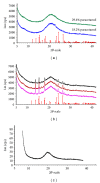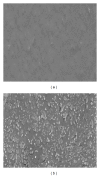Improving drug loading of mucosal solvent cast films using a combination of hydrophilic polymers with amoxicillin and paracetamol as model drugs
- PMID: 23841056
- PMCID: PMC3693112
- DOI: 10.1155/2013/198137
Improving drug loading of mucosal solvent cast films using a combination of hydrophilic polymers with amoxicillin and paracetamol as model drugs
Abstract
Solvent cast mucosal films with improved drug loading have been developed by combining carboxymethyl cellulose (CMC), sodium alginate (SA), and carrageenan (CAR) using paracetamol and amoxicillin as model drugs and glycerol (GLY) as plasticizer. Films were characterized using X-ray powder diffraction (XRPD), scanning electron microscopy (SEM), folding resilience, swelling capacity, mucoadhesivity, and drug dissolution studies. SA, CMC, and GLY (5 : 3 : 6) films showed maximum amoxicillin loading of 26.3% whilst CAR, CMC, and GLY (1 : 2 : 3) films had a maximum paracetamol loading of 40%. XRPD analysis showed different physical forms of the drugs depending on the amount loaded. Films containing 29.4% paracetamol and 26.3% amoxicillin showed molecular dispersion of the drugs while excess paracetamol was observed on the film surface when the maximum 40% was loaded. Work of adhesion was similar for blank films with slightly higher cohesiveness for CAR and CMC based films, but the differences were significant between paracetamol and amoxicillin containing films. The stickiness and cohesiveness for drug loaded films were generally similar with no significant differences. The maximum percentage cumulative drug release was 84.65% and 70.59% for paracetamol and amoxicillin, respectively, with anomalous case two transport mechanism involving both drug diffusion and polymer erosion.
Figures





Similar articles
-
Characterisation of freeze-dried wafers and solvent evaporated films as potential drug delivery systems to mucosal surfaces.Int J Pharm. 2010 Apr 15;389(1-2):24-31. doi: 10.1016/j.ijpharm.2010.01.008. Epub 2010 Jan 18. Int J Pharm. 2010. PMID: 20083177
-
Development and mechanical characterization of solvent-cast polymeric films as potential drug delivery systems to mucosal surfaces.Drug Dev Ind Pharm. 2009 Aug;35(8):986-96. doi: 10.1080/03639040902744704. Drug Dev Ind Pharm. 2009. PMID: 19365780
-
In vitro drug release studies of polymeric freeze-dried wafers and solvent-cast films using paracetamol as a model soluble drug.Int J Pharm. 2009 Aug 13;378(1-2):66-72. doi: 10.1016/j.ijpharm.2009.05.038. Epub 2009 May 27. Int J Pharm. 2009. PMID: 19477255
-
Novel films for drug delivery via the buccal mucosa using model soluble and insoluble drugs.Drug Dev Ind Pharm. 2012 Oct;38(10):1207-20. doi: 10.3109/03639045.2011.644294. Epub 2011 Dec 29. Drug Dev Ind Pharm. 2012. PMID: 22204701
-
Development and evaluation of pH-sensitive sodium alginate/chitosan microparticles containing the antituberculosis drug rifampicin.Mater Sci Eng C Mater Biol Appl. 2014 Jun 1;39:161-7. doi: 10.1016/j.msec.2014.01.054. Epub 2014 Feb 10. Mater Sci Eng C Mater Biol Appl. 2014. PMID: 24863212 Review.
Cited by
-
Safety and Pharmacokinetics of Quick-Dissolving Polymeric Vaginal Films Delivering the Antiretroviral IQP-0528 for Preexposure Prophylaxis.Antimicrob Agents Chemother. 2016 Jun 20;60(7):4140-50. doi: 10.1128/AAC.00082-16. Print 2016 Jul. Antimicrob Agents Chemother. 2016. PMID: 27139475 Free PMC article.
-
Spontaneously Self-Assembled Microgel Film as Co-Delivery System for Skincare Applications.Pharmaceutics. 2021 Sep 8;13(9):1422. doi: 10.3390/pharmaceutics13091422. Pharmaceutics. 2021. PMID: 34575498 Free PMC article.
-
Formulation of Novel Layered Sodium Carboxymethylcellulose Film Wound Dressings with Ibuprofen for Alleviating Wound Pain.Biomed Res Int. 2015;2015:892671. doi: 10.1155/2015/892671. Epub 2015 May 18. Biomed Res Int. 2015. PMID: 26090454 Free PMC article.
-
Sulfated Seaweed Polysaccharides as Multifunctional Materials in Drug Delivery Applications.Mar Drugs. 2016 Feb 25;14(3):42. doi: 10.3390/md14030042. Mar Drugs. 2016. PMID: 26927134 Free PMC article. Review.
-
Formulation, characterisation and stabilisation of buccal films for paediatric drug delivery of omeprazole.AAPS PharmSciTech. 2015 Aug;16(4):800-10. doi: 10.1208/s12249-014-0268-7. Epub 2015 Jan 6. AAPS PharmSciTech. 2015. PMID: 25559373 Free PMC article.
References
-
- Sangalli ME, Maroni A, Zema L, Busetti C, Giordano F, Gazzaniga A. In vitro and in vivo evaluation of an oral system for time and/or site-specific drug delivery. Journal of Controlled Release. 2001;73(1):103–110. - PubMed
-
- Liekweg A, Westfeld M, Jaehde U. From oncology pharmacy to pharmaceutical care: new contributions to multidisciplinary cancer care. Supportive Care in Cancer. 2004;12(2):73–79. - PubMed
-
- Shojaei AH. Buccal mucosa as a route for systemic drug delivery: a review. Journal of Pharmacy & Pharmaceutical Sciences. 1998;1(1):15–30. - PubMed
-
- Senel S, Kremer M, Nagy K, Squier C. Delivery of bioactive peptides and proteins across oral (Buccal) mucosa. Current Pharmaceutical Biotechnology. 2001;2(2):175–186. - PubMed
-
- Barich DH, Munson EJ, Zell MT. Drug delivery principles and applications. In: Wang B, Siahaan T, Soltero R, editors. Physicochemical Properties, Formulation and Drug Delivery. New York, NY, USA: Wiley Interscience; 2005. p. p. 69.
MeSH terms
Substances
LinkOut - more resources
Full Text Sources
Other Literature Sources
Miscellaneous

